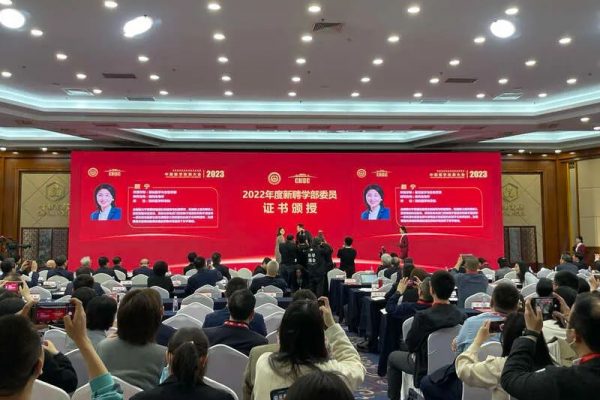硅光大Richard Soref发表芯片封面文章:基于微格GaP/Si超晶光子环源器件的精密微晶和量子
FUTURE远见| 2022-07-15
Future|远见
Future|远见future选编
该研究提出了一个新型的基于GaP/Si短周期超晶格(short-period superlattice, SPSL)光学波导以及微环状谐振器的超晶体-绝缘体(superlattice-on-insulator, SLOI)复合结构。文章提出,以低折射率SiO₂为包层,基于GaP/Si SPSL的条状波导网络具有低的光损耗,可运用于复杂的光子集成线路(photonic integrated circuit, PIC)。作者提出,该种SLOI-PIC在量子-光子芯片(quantum-photonic chip, QPC)上具有潜在的重要应用。
本工作所提出的SLOI-PIC所具有的光子响应取决于构成其线路的SPSL的结构。基于GaP/Si的SPSL由n层GaP双原子层与m层Si₂单质层交替搭建而成,在纳米层级呈现出m/n/m/n/m/n …的交叠形式。通过调节n和m的数值,可实现对以上SPSL结构的价带-导带能带跃迁性质的控制。同时,该种SPSL结构的生长方向亦会影响其光子学性质。在同一工作中,作者通过理论推导和模拟,预测了该种SLOI-PIC作为经典和量子光源的非线性光学响应,以及其光电泡克尔斯效应(electron-optical Pockels effect, EOPE)。作者通过模拟结果指出,适当地调节n和m可放大上述结构的非线性光学性质和EOPE,进而实现一种新型的泛用性SLOI-PIC平台。
该平台将具有以下四大特征:
1.低损耗的光子线路,例如:分光器、 合光器、谐振器等;
2.对于量子或谐波光源的二阶或三阶非线性响应;
3.通过干涉仪实现的EOPE相移和/或强度调制;
4.EOPE空间路由。
文章内容英文介绍如下:
Classical and Quantum Photonic Sources based upon a Nonlinear GaP/Si-Superlattice Micro-Ring Resonator
The Si/GaP short period superlattice (SPSL) that is presented and analyzed in the current work¹ is just one example of several new, undoped, lattice-matched nano-photonic semiconductor systems that include the Si/AlP, Si/ZnS, 3C-SiC/AlN, Ge/GaAs, and Ge/ZnSe SPSLs². These are “man-made” semiconductors whose bandgap is the approximate average of the two constituent bandgaps, and the transparency range for some of these SLs can extend from traditional telecom wavelengths into the visible region.
In order to provide well-confined optical waveguiding within the plane of the SPSL, we propose to first grow the SPSL stack by molecular-beam epitaxy upon a large-area lattice-matched handle wafer such as 300-mm-diameter silicon, using a few hundred periods of layering to give a uniform and monolithic stack across the wafer. After that, the handle is bonded to an oxidized silicon wafer having about 2 μm of top SiO₂. Next, the material above the SL is cut away to leave only the stack, thus creating a superlattice-on-insulator (SLOI) structure. Below this structure is a buried oxide, which is a lower-index, lower optical-cladding for the SPSL that produces mode bunching in the multilayer. This large-area SPSL, with stack thickness of 376 to 565 nm, is then photo-etched to create a network of low-loss SPSL strip waveguides configured into a complicated photonic integrated circuit (PIC).
At present, our proposed GaP/Si SLOI-PIC does not go beyond a theoretical vision, as we await the construction and experimental testing of the novel circuits. A key example of such a PIC is the circuitry used to create a quantum-photonic chip (QPC). The chip’s photonic responses are governed by the SPSL’s valence-to-conduction energy-band transitions (linked to its nano-layering) and by the growth direction such as [111]. The number of monolayers of Si₂ is denoted as m and the number of two-atom layers of GaP is n, so this SPSL is built with the lengthy alternation m/n/m/n/m/n, etc.
For both classical and QPC light sources, a theoretical-physics approach is used in this article to make a series of predictions about the nonlinear optical response and the electro-optical Pockels-effect (EOPE) modulation-and-switching that are offered by the SLOI-PIC. The platform can be optimized via judicious m, n selection for a single purpose such as achieving “giant” second-order and third-order nonlinear optical susceptibilities, χ⁽²⁾ and χ⁽³⁾ respectively. Using those nonlinearities to yield an on-chip source of entangled photon pairs on the QPC, such photons are triggered by a laser pump illustrated in red in Fig. 1, a pump that is usually sited off-chip and coupled by optical fiber to an input area of the chip.
Fig. 1 | On-chip generation of entangled photon pairs via spontaneous four-wave mixing in waveguided, SLOI bus-coupled micro-ring resonator.
A high-Q SPSL micro-ring resonator enables efficient pair generation at modest pump power. For the Si/GaP χ⁽²⁾ -optimized case, the pairs are generated by spontaneous parametric down-conversion (810-nm pump, 1626-nm signal, 1614-nm idler). For the Si/GaP χ⁽³⁾ pair source, the spontaneous four-wave mixing generator utilizes the strong nonlinear Kerr index n2 of the SPSL (1548.5-nm pump. 1543.5-nm signal, 1553.5-nm idler). For classical chips that are driven by a classical light source, it is believed feasible to utilize TM0 “harmonic light” at the wavelength-of-operation. Using a sub-harmonic TM2 laser pump, the primary operating light comes from efficient on-chip SLOI second-harmonic generation via large χ⁽²⁾, or from efficient SLOI third-harmonic generation via large χ⁽³⁾.
Fig. 2 | Application-specific example of CMOS-compatible SLOI-PIC quantum-photonic chip including SWFM photons- sources, EOPE phase shifters, EOPE 2 x 2 switches, and photo-detectors. This is a modified version of Fig. 1 in the work by Xiong and colleagues³.
It is expected that a compromise choice of m, n will yield reasonably large values of both the nonlinear effect and the EOPE response in order to create a general SLOI-PIC platform that has four features: (1) low-loss strip circuitry such as splitters, combiners, resonators, etc., (2) second- or third-order nonlinear optical response for pumped quantum or harmonic light sources, (3) EOPE phase shifting and/or intensity modulation via an interferometer, and (4) EOPE spatial routing. There is a variety of four-purpose chips, one of which is sketched in Fig. 2. In the Si/GaP platform, the χ⁽²⁾ is comparable to that of AlGaAs and the n2 is much larger than that of AlGaAs. The r33 Pockels coefficient is much larger than that of any compound semiconductor. Hopefully, future experiments will validate these theories, and in such demonstrations, fine control of hetero-interfaces will be essential.
作者信息
Richard A. Soref毕业于美国斯坦福大学。现任美国马萨诸塞大学波士顿分校工程学院研究教授,电子电气工程师学会终身会士(IEEE Life Fellow),Optica(前美国光学会,OSA)会士,2019年国际工程与技术学会(IET)终身成就奖章(Achievement Medal)获得者。在其迄今长达58年的科研生涯中,Soref教授对硅基光子学领域做出过奠基性、突出性贡献。至今,Soref教授已累计发表研究论文近600篇,并著有11个专著章节,拥有54项美国专利。谷歌学术显示Soref教授著作至今已累计被引用近29000次,h指数80。
Francesco De Leonardis毕业于意大利巴里理工大学,自2018年起担任巴里理工大学电子与信息工程系副教授。De Leonardis教授同时担任意大利国家核物理所副研究员以及光子纳米技术所副研究员。至今De Leonardis教授已累计发表超过150篇研究论文,并持有1项国际专利。谷歌学术显示De Leonardis教授至今已累计被引近2100次,h指数23。
关于Chip
Chip是全球唯一聚焦芯片类研究的综合性国际期刊,已入选由中国科协、教育部、科技部、中科院等单位联合实施的「中国科技期刊卓越行动计划高起点新刊项目」,为科技部鼓励发表「三类高质量论文」期刊之一。
Chip期刊由上海交通大学与Elsevier集团合作出版,并与多家国内外知名学术组织展开合作,为学术会议提供高质量交流平台。
Chip秉承创刊理念: All About Chip,聚焦芯片,兼容并包,旨在发表与芯片相关的各科研领域尖端突破性成果,助力未来芯片科技发展。迄今为止,Chip已在其编委会汇集了来自13个国家的68名世界知名专家学者,其中包括多名中外院士及IEEE、ACM、Optica等知名国际学会终身会士(Fellow)。
Chip第二期已于2022年7月在爱思唯尔Chip官网以金色开放获取形式(Gold Open Access)发布,欢迎访问阅读文章。
爱思唯尔Chip官网:
https://www.journals.elsevier.com/chip
论文链接
https://www.sciencedirect.com/science/article/pii/S2709472322000090
参考文献
[1]Soref, R. and De Leonardis, F. Classical and quantum photonic sources based upon a nonlinear GaP/Si-superlattice micro-ring resonator. Chip 1, 100011 (2022).
[2]De Leonardis, F. and Soref, R. High-performance Pockel’s-effect modulation and switching in silicon-based Si/GaP, Si/AlP, Si/ZnS, 3C-SiC/AlN, Ge/GaAs and Ge/ZnSe superlattice-on-insulator integrated circuits (unpublished, 2022).
[3]Xiong, C., Bell, B. and Eggleton, B. J. CMOS-compatible photonic devices for single-photon generation. Nanophotonics 5, 427-439 (2016).
Warning: Invalid argument supplied for foreach() in /www/wwwroot/www.futureyuanjian.com/wp-content/themes/future/single-news.php on line 41



